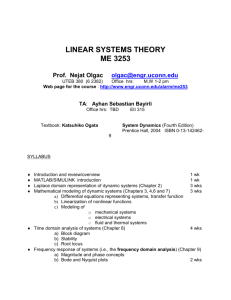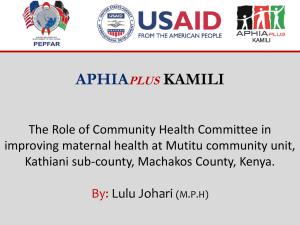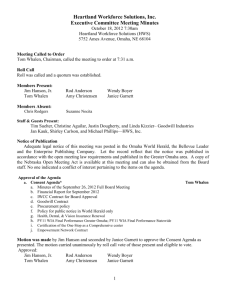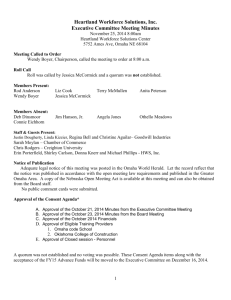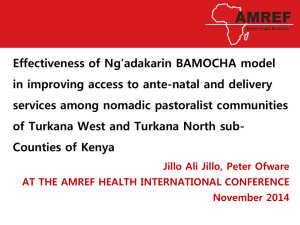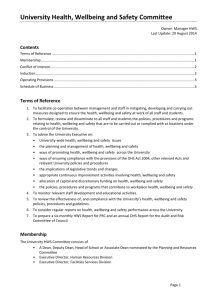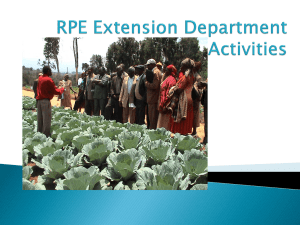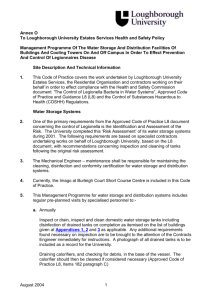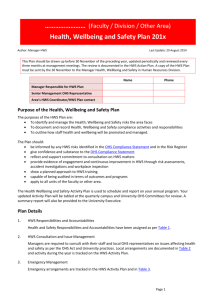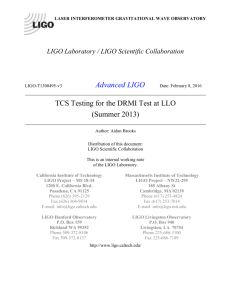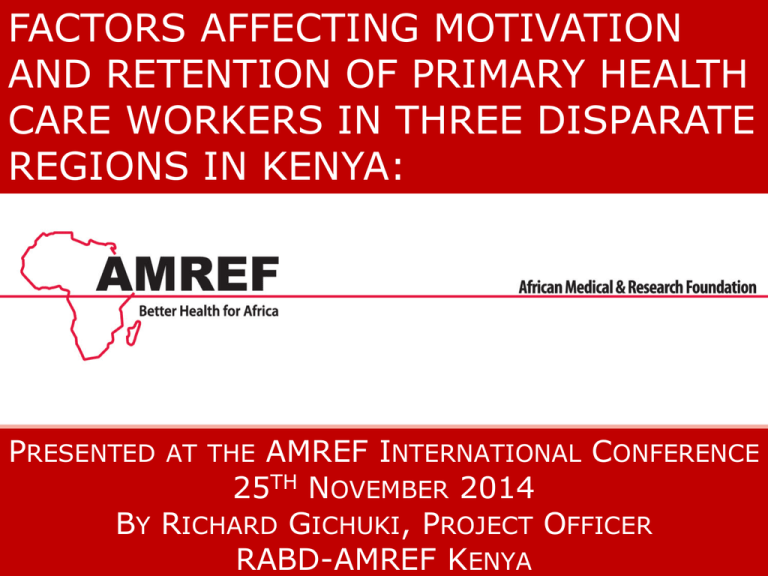
FACTORS AFFECTING MOTIVATION
AND RETENTION OF PRIMARY HEALTH
CARE WORKERS IN THREE DISPARATE
REGIONS IN KENYA:
PRESENTED AT THE AMREF INTERNATIONAL CONFERENCE
25TH NOVEMBER 2014
BY RICHARD GICHUKI, PROJECT OFFICER
RABD-AMREF KENYA
PRESENTER DISCLOSURES
Richard Gichuki
No relationships to disclose
2
OUTLINE
• Background
• Study objectives
• Methodology
• Results
• Discussion
• Conclusion and recommendations
BACKGROUND
•Human resources for health
(HRH) is one of the six building
blocks of the health systems –WHO
•Report published in 2004
estimated 1m additional HWs in
sub-Sahara Africa.
•Attracting and retaining HWs in
Kenyan Health system has been a
challenge.
•Baseline study conducted in 2011
and published in HRH journal
(http://www.human-resourceshealth.com/content/12/1/33/abstract )
BACKGROUND_CONCEPTUAL
FRAMEWORK
• “Push and pull factors” that determine movement
of personnel (Padarath A, et all; 2003)
Push Factors-leave
Pull Factors-Attract
Low remuneration and salaries
Levels of morale
Lack of Job satisfaction
Rewards and Incentives
Work associated risks
Social values
Lack of further education and career
development opportunities
Barriers to migration
Lack of education opportunities for
children
Low quality of life and high levels of
crime
5
STUDY OBJECTIVES
• Main objective
–Investigate whether factors related to the
motivation and retention of HWs differ across the
three different settings in Kenya
• Specific objectives
– To investigate whether socio-demographic
characteristics of the respondents varies across the
disparate setting.
– To determine whether work environment factors
differ across the three settings
– To determine whether factors related to job
satisfaction differ across the three settings.
METHODOLOGY
• Cross sectional mixed
methods design utilizing
quantitative and qualitative
methods
• Sampling technique:
– Cluster sampling used to select 81
facilities where 361 HWs were drawn
– Purposive sampling: FGDs (7) and
In-depth interviews (30)
• Study Population and sites
– HWs mainly from primary level fac’
– 3 counties visited -Turkana North,
Machakos County, Kibera in Nairobi
County
DATA COLLECTION AND
ANALYSIS
• Data analyzed through:
−Content analysis of qualitative
information
−Descriptive statistics
−Proportions
−Bi-variate analysis
−Chi-square test
−0.05 level of significance used.
8
Ownership of Facilities by Region
9
SERVICE PROVIDER BY
REGION
Type of Service Provider
Administrator
CHEW
CHW
Clinical Officer
Lab Technician
Lay Counsellor
MO
Nutritionist
Parmacists
Registered Nurse
Support Staff
Allied Professional
Total
Nairobi
(n=101)
%
2.0
1.0
10.9
9.9
11.9
3.0
2.0
7.9
5.0
33.7
5.0
7.9
100.0
Machakos
(n=143)
%
3.0
2.1
3.5
7.7
11.2
1.4
4.9
2.8
2.1
44.8
9.8
6.3
100.0
Turkana
(n=102)
%
1.0
3.9
14.7
9.8
4.9
5.9
1.0
5.9
4.9
32.4
2.9
12.7
100.0
Total
(n=346)
%
2.0
2.3
9.0
9.0
9.5
3.2
2.9
5.2
3.8
37.9
6.4
8.7
100.0
RESULTS: BACKGROUND
CHARACTERISTICS OF
RESPONDENTS
Characteristic
Sex
Age
Post Sec Educ
Nairobi Machaks Turkana
Category
(n=101) (n=143) (n=102) P-value
Male
Female
<35
>35
38%
62%
63%
37%
33%
67%
52%
48%
55% 0.001
45%
77% 0.004
23%
Yes
89%
79%
78% 0.001
No
11%
21%
22%
38%
62%
42%
58%
35% 0.373
65%
Alternative
Yes
Sources of IncomeNo
RESULTS: TRAINING
CHARACTERISTICS OF
PROFESSIONAL HEALTH WORKERS
Characteristic
Category
Yes
Attended
Upgrading Course No
Highest level of Diploma
upgrading course Masters
attended
Other1
Nairobi Machaks Turkana
(n=100) (n=136) (n=98) P-value
45%
35%
34%
0.096
55%
22%
16%
65%
40%
2%
66%
27%
0%
0.01
62%
57%
73%
“The other thing apart from money for their own pockets there are
also money for trainings like if you have a certificate in nursing the
county health team should give you money to go and train in that way
you will attract more people” FGD-Turkana
RESULTS: JOB
SATISFACTION
% of respondents reporting Machakos Nairobi Turkana P-Value
Satisfied with their job
35.3
43.6
43.2 0.563
Job good match for skills
63.0
78.2
68.2 0.334
Recognition for doing work
52.1
55.4
65.9 0.246
Training have been provided
to succeed in their work
61.3
74.3
53.4
0.034*
Morale level at depart’ is
good
42.0
58.4
60.2
0.046*
Feels protected from comm’
diseases (HIV)
56.3
73.3
69.3
0.045*
RESULTS: ASSESSMENT
OF WORK ENVIRONMENT
% of respondents
Machakos Nairobi Turkana P-value
Workload is manageable
37.2
71.6
64.0 <0.001
Good access to drugs
37.2
71.6
64.0 <0.001
Equip’s to do their job
19.8
30.4
33.7
0.264
Efficient transp’ to work
33.1
54.0
31.4
0.001
Job allwd relx dur’ Lunch
43.0
77.5
77.9 <0.001
Good schooling for child’
Good access to water
46.0
47.1
46.1
70.6
36.0 0.193
62.8 <0.001
RESULTS: ASSESSMENT OF
WORK ENVIRONMENT
• “I think that one of the challenges that people
experience is the means of transport whereby in
case you have some emergency and you want to
report to the work-station you cannot get there in
good time so transport is a major challenge”
FGD-Turkana
• “Water is not available for 24 hours because we
are using a bore hole that is using a generator, I
mean source of power. So when there is
mechanical problems the patients go without
water” FGD-providers Machakos.
15
RESULTS: RENUMERATION
PACKAGE
• Enough
promotion
opport’= 40%
• Enough
Training
opport’= 32%
• While 18% felt
that their
salary is fair
16
RESULTS: RENUMERATION
PACKAGE
• “By increasing the hardship allowance and for example if
you are working in Kenyatta and you are being paid
100,000 if you go to Kitui and the pay is made at 200,000
then they will come” FGD-Providers-Machakos
• “Enhanced allowances like house allowance a fellow on
Kitale receives more than a person in Lodwar and when it
comes to hardship when you are not married you get
Kshs. 600. What does that mean? Is it standard? There
are a lot of things that de-motivate one from working here
especially when it comes to the issue of allowances”
FGD-Providers –Turkana
17
DISCUSSION
• Provider working in Nairobi county twice more
likely to have undergone at least one training
since post basic training compared to other
counties OR: 2.1 (1.2, 4.22).
• Provider working in Turkana county 90% more
likely to be younger(<35yrs) than other counties
OR: 1.9 (1.1, 3.7).
• Turkana county had the highest proportion of
male respondents (54%) compared to Machakos
(32%) and Nairobi (35%).
CONCLUSION
• Retaining HWs at their places of work hinges on
several issues: remuneration including allowances,
as well as good infrastructure.
• County Governments though still new in their
functions, have an unprecedented opportunity to
offer incentives that could encourage HWs to
remain in the rural and remote areas
• Attracting HWs to rural and remote areas will
require creative approaches
• Workers already employed in the rural and remote
regions face a number of constraints that curtail
their ability to offer health care to patients
RECOMMENDATIONS
• Attracting HWs to rural areas
– Engage county governments to improve infrastructure
in counties
– Engage potential HWs to work in rural and remote
areas
• Retaining HWs in rural areas
– Address HWs remuneration package
– Improve working environment in HFs
– Make the HWs comfortable especially those in rural and
remote areas
– Focus on health managers as an important variable in
health worker motivation
• Need for further analysis of the data for more results
ACKNOWLEDMENT
• European Union for Funding
• World Vision Kenya as prime Partner
• County Health management Teams for
facilitating the survey
• HCWs
• AMREF ESRC for ethical approval
• Research team
Thank you

